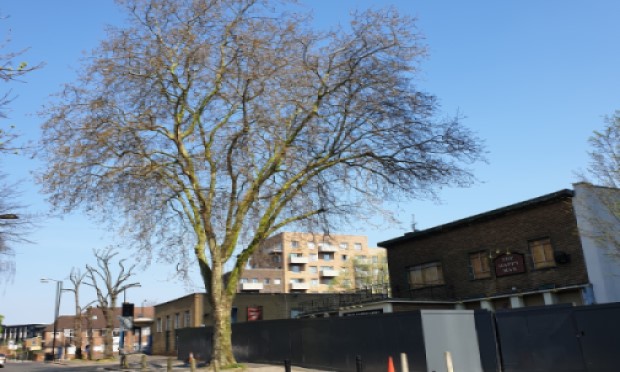Woodberry Down locals fight to save Happy Man Tree from destruction by developers

Hackney locals have voiced their alarm at plans to cut down a beloved London plane tree as part of the redevelopment of the Woodberry Down estate by Berkeley Homes.
The plans will be discussed this week by councillors as part of their decision on the third phase of the widescale regeneration of the estate, which would next see the demolition of five blocks comprising 260 homes, the former Robin Redmond community centre, and the Happy Man pub and its tree.
Four residential blocks of up to 20 storeys would then be built, including 584 homes, 1,045 square metres of further flexible floorspace, an energy centre and a new public park.
Of the housing, 42 per cent would be classed as ‘affordable’, with 117 homes to be offered for social rent and 126 for shared ownership and shared equity, with the remaining 341 for private sale.
The loss of the Happy Man Tree as part of the plans has residents up in arms, with local artist Peter Gosnell, 92, voicing his sadness that the streets on which he has lived for 65 years have become “denuded” of nature as part of Berkeley’s regeneration.
Gosnell said: “I am appalled that developers Berkeley Homes have even entertained felling this tree. It is a London Plane, an icon of London, over 150 years old, Grade ‘A’, 22 metres in height and only about 100 metres from Woodberry Wetlands.
“If space for this tree cannot be justified in the development, it indicates that space must be at an absolute premium and the application deserves very close scrutiny.
“I have lived in Woodberry Down since 1955, for exactly 65 years yesterday. The four generations of my family who have lived here have participated in many aspects of local community life.
“Prior to the regeneration, the street scene of Woodberry Grove and the road, Woodberry Down were well known to me because my parents lived in Nicholl House from 1954 and I had close associations with St Olave’s Church and Woodberry Down Comprehensive School.
“I am saddened that it has been denuded of mature broad leaf trees by Berkeley Homes; London planes, horse chestnuts and lime trees as well as fruit trees, including mulberry and pear, have been stripped away. I and others mourn the loss of these and the loss of our own sense of place.”
Planning officers have recommended the third phase of the Woodberry Down for regeneration with the Happy Man Tree’s loss priced in, saying that keeping the venerable plane would result in “design harm and reduction in affordable housing”.
However, Gosnell’s opposition to the tree’s removal is shared by Geoff Bell, former chair of the Woodberry Down Community Organisation (WDCO) and longtime supporter of the regeneration plans, as well as two other WDCO members.
In an open letter to planning officers, Bell questioned why a tree preservation order made to safeguard the Happy Man Tree had not been acknowledged, and claims that widespread consensus had been reached at earlier stages that were the tree to be kept, any loss of homes could be made up for by adding to the height of other blocks.
Part of the recommendation to approve the plans by officers stipulates that, were they to go ahead, the value of the tree would be repaid to compensate for the harm to the community by its loss, calculated at £175,000.
Officers accept that the loss of the Happy Man Tree represents “substantial harm to biodiversity and the public amenity of the local area”, with the £175k attendant on its loss to be secured with a legal agreement with the developer to plant replacement trees in the neighbourhood.
In a report on the plans, Town Hall officers wrote: “A mature London Plane is to be lost from the public highway on Woodberry Grove adjacent to the former Happy Man Public House.
“Various options to retain the tree have been explored during the course of the application, including omission of parts of Building A1. However it was concluded that the design harm and reduction in affordable housing that would result from the options investigated would outweigh the benefit of retaining the tree.
“Whilst the loss of the tree would be regrettable it is considered that the suggested contribution, together with the other biodiversity and landscaping benefits referred to in this report, will be sufficient to ensure that biodiversity and public amenity impacts are adequately mitigated.”
